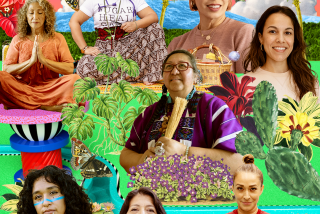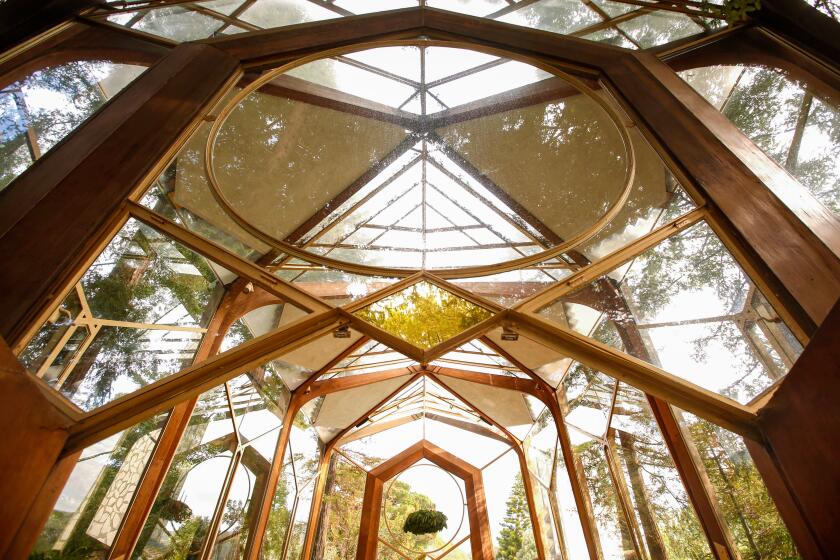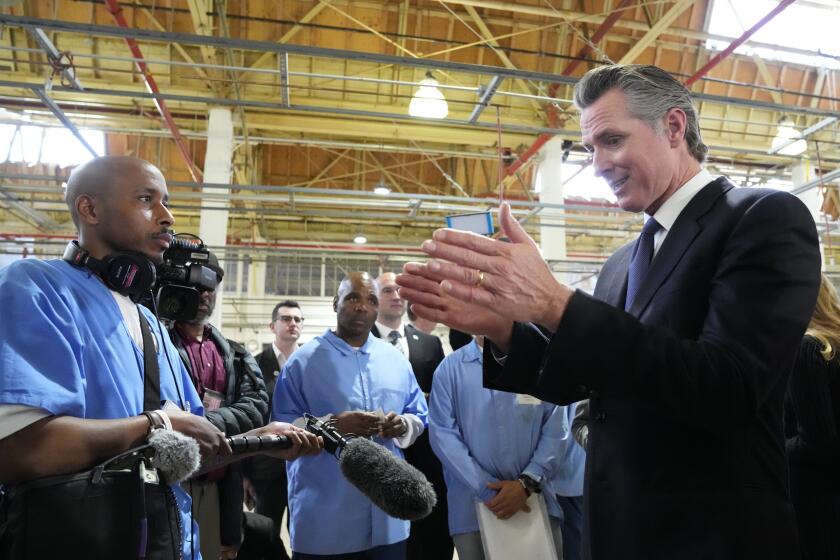East Wind Center Comforts Strangers in a Strange Land
- Share via
Every week for the last two years, Xay Kaignavongsa has made forays into fierce nightmares.
Each day the Laotian counselor sifts through the psyches of the mentally ill refugees he meets at the East Wind Socialization Center in Linda Vista, purging their bad thoughts, cultivating the good ones.
Trying, some say, to raise the dead.
“People come here very, very scared,” Kaignavongsa said, his speech slow but determined. “Many have seen their families get killed by Communist soldiers. Some have family in concentration camps. They are alone in a strange country, and they feel isolated.
“Some, because they have seen their families die, think that they have died, that America is the afterlife. They feel bad and have bad dreams about this. It’s very hard, but I have to go where they are and try to guide them away from those nightmares, those feelings.”
But Kaignavongsa, 43, is not alone. As part of a group of four from the Linda Vista center, he meets five days a week with mentally ill Southeast Asian refugees from across San Diego in this pioneer program.
Long-Ignored Problem
As the only center of its kind in the county, East Wind seeks to address an Asian mental health problem long overlooked because of the dearth of Southeast Asian mental health care specialists.
“We are just now starting to see some Vietnamese workers in mental health care,” said Roberta Peterson, director of East Wind. “Up until now, there have been almost no Southeast Asian psychologists or counselors.”
Together, she and the three East Wind counselors work like a team of spiritual tailors, struggling to re-stitch souls that have been shredded by war and illness.
“We focus on three things: fitness, learning resources and recreation,” Peterson said. “We try to get them to be as active and live as full a life as possible. They take English courses, they play games, we go on field trips. Every day this group’s life is a little better.”
For this group, slight improvements can often register like quantum leaps.
“I like East Wind,” said Nom Choumphavong, 28, a Laotian woman who suffers depression. “(I’ve been) coming here for about 1 1/2 years. I draw pictures and I work now. (At home) I didn’t do much. This (center) is good.”
Like their illnesses, which include depression, schizophrenia and psychosis, the patients’ pasts are varied. And though they are all Southeast Asians, geographic proximity means little to men and women whose cultures have left them worlds apart.
“Different ethnic groups usually don’t spend time at the center together,” Peterson said. “There are many historic animosities among them. Not all of them get along. This is why we have different days for different groups and so many different language capabilities.”
Though the center is geared toward Asian outcasts, Peterson is quick to point out that East Wind’s facilities are open to others.
“Anyone with mental illness is welcome,” Peterson said. “It’s not an all-Asian program.” Nevertheless, the center, which serves 77 people, now has an exclusively Asian clientele.
As a result, East Wind has had to take major, and sometimes costly, steps to scale the cultural barriers.
“Our staff members speak Lao, Cambodian and Vietnamese,” she said. “When we started, the language capability was the first thing we needed. Formal training had to be sacrificed.”
Still, Peterson commends the East Wind staff for keeping the program alive.
“They’re absolute gems,” she said. “The program is so dependent on them. Their pay is pathetic, but it’s a reward enough that they can help their own people.”
The counselors, who are all Asian immigrants, said their greatest asset is their ability to relate to many of their clients’ anxieties.
For instance, explained Kaignavongsa, it’s no accident that he can navigate his clients’ nightmares:
They were once his own.
“I had those same dreams of trying to escape and being caught and harmed by the Communists,” said Kaignavongsa, who escaped from Laos with his wife and elder child eight years ago. “I understand what it is like to be afraid, to feel isolated. So I tell them, ‘Cry. Cry out.’ This is how we help solve the problem.”
For one 22-year-old Hmong man, the crying has finally begun to chip away the terror.
“When I feel scared I don’t come here,” said the man, an agoraphobic (the fear of crossing or being in open spaces) who chose not to be named. “When I feel a little bit stronger, I come here. Xay and people here help me.”
But the man knows that the road to recovery still stretches far ahead.
“When I go outside, it makes me scared,” said the man, who will not venture from his home without a ski mask covering his face. “Sometimes, I forget about my family, what their name (is). I feel very angry. Before, my brain was working well. I could go out to store . . . drive (a) car anywhere . . . go to the beach. (Now) my body (does) not help me to do well. (There’s) pain inside (my) heart.
” . . . If somebody says something bad about me, I want to kill them.”
Such are the mind-sets that face the East Wind counselors. Still, they remain confident.
“You have to go to their level,” said Yen Tran, 24, a San Diego State University student from Vietnam who also counsels East Wind clients. “You have to put yourself in their position, but not for too long; it’s depressing. I have to try to bring them into the American mainstream.”
Use Indirect Approach
But in achieving this aim, Tran said, she sometimes has to modify--or even discard--some of her formal training because of its American biases.
“Usually, in college,” she said, “they teach you how to deal with Americans. Americans are very straightforward, direct. Asians, we are more passive. When you ask Asians something, you have to be more respectful, more indirect.”
“When you ask them something,” added Peterson, who majored in social work at San Diego State, “they’ll decline three times before they finally accept. We have people who have been coming for weeks that we still have to ask to come every day. That’s because they have to think you really want them here.”
Be persistent, not obstinate: This is East Wind’s unspoken philosophy. Yes, said Peterson, the counselors want to help their clients, going so far as to use their own cars to pick up the refugees.
But, no, they will not run roughshod over Asian culture with American ideas.
“People from Asia aren’t used to mental health services,” she said. “You can’t just open up your doors and say, ‘OK, here we are!’ You publicize yourself in their community, at their shops, in the Buddhist temples, anywhere they are. You cajole them. You try to engage them . . . And, to work with them, you often have to be willing to accept their reasons for their illnesses.
“We have people who believe they are cursed. They think that is why they are sick. We know different, but to help them, we have to say, ‘Fine, you were cursed.’ ”
The counselors are also aware that their clients receive outside therapy and view their jobs as supplementing that therapy.
“They only meet with psychiatrists once (or) twice a month,” Kaignavongsa said. “Maybe they don’t have enough time to spend with psychiatrists. That is where we hope we can be of some help.”
Supplementing that clinical aid has been East Wind’s primary purpose since it was started in 1985 by the Union of Pan-Asian Communities.
“UPAC has about eight other programs,” she said. “But they wanted a program that would provide mentally ill people an opportunity to be more active than they would at a hospital. Also, this is a lot cheaper than putting people in a hospital.”
She said the state provides the $100,000 annual budget that finances the center, which is free for the refugees. East Wind also receives cash contributions from the San Diego community, as well as donations of clothes, games and furniture.
“We’ve gotten a lot of help from people in the San Diego area,” she said. “In fact, the fifth grade at Country Day (School) adopted our clients. The people around here seem to care a lot.”
But, Peterson points out, not everyone welcomes her clients. At times, the refugees have become targets of callous verbal attacks, she said, recounting one epithet-spewing incident at Mission Beach.
“We were there for a field trip and some young people gave us a hard time, yelling all kinds of racial slurs,” she said. “I don’t know if (the refugees) were aware of what they meant or not, but it wasn’t nice.
“We also went to one jewelry store in La Jolla Village Square and got a chilly reception. But there, people just stared.”
Peterson conceded that there is some anti-Asian sentiment in the city but her clients, much to her displeasure, have grown accustomed to it.
“Sadly, because of their fatalism, they don’t tell me about anything I don’t see,” she said. “They just accept it as part of life in America.”
The East Wind staff is quick to add, though, that bigots compose only a small fraction of the San Diegans they encounter. Their program, they say, has been embraced warmly by the community at large.
“Most of the people that see us are very nice,” Peterson said. “I think San Diego has a lot of caring people out there.”
That may be, but it is the unyielding love of the staff that keeps East Wind afloat. Armed with little more than a fierce sense of nationalism, Kaignavongsa and Yen and the other counselors march headlong into the scarred psyches of “our people.”
“I know I don’t make much money, but I am able to help my people,” Kaignavongsa said. “I try to walk through their fears with them, because I know we share the same thing. My family and me, we are so lucky, so very, very lucky. I have to help those who have not been.”
More to Read
Sign up for Essential California
The most important California stories and recommendations in your inbox every morning.
You may occasionally receive promotional content from the Los Angeles Times.













